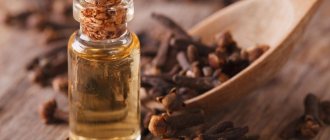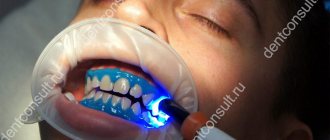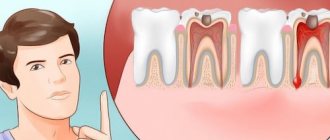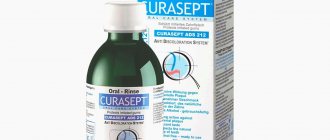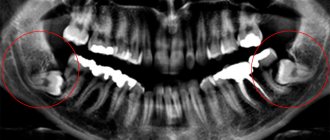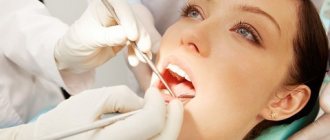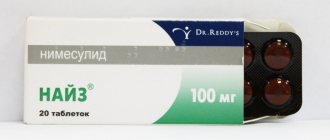The health of teeth and gums is determined not only by the quality of oral care, but also largely depends on a person’s diet. It is important that the foods you eat daily contain calcium, phosphorus, fluorine, magnesium, zinc, iron, vitamin D3, A, K, C, E, B vitamins, Omega-3 fatty acids, beta-carotene, etc. All these substances necessary for healthy teeth and gums are part of a completely familiar meal. Knowing foods that are good for your teeth will help you properly balance your diet and avoid many dental problems by simply eating tasty and healthy foods.
What fruits and berries are good for teeth and gums
The main fruits and berries recommended for oral health are:
- citrus fruits (the whole variety of fruits of this family) - due to the high content of calcium, phosphorus and vitamin C, they contribute to overall strengthening and prevent possible inflammation of the gums;
- apples – fight plaque, effectively cleaning teeth, and also provide gentle gum massage and contain useful macro- and microelements;
- grapes - despite their sweetness, the use of these fruits helps to destroy pathogenic microflora. Grape juice contains a large amount of organic acids and beneficial minerals;
- Kiwi is a fruit rich in ascorbic acid. Its use is useful not only for tooth growth, but also for the synthesis of collagen, the deficiency of which can lead to periodontal disease;
- Strawberries - in addition to useful substances, contain malic acid, which gently cleanses teeth and carefully whitens enamel.
These are just the main and most common fruit and berry crops that have a positive effect on the health of teeth and gums. In general, fresh fruits and berries have a beneficial effect on oral health, since, regardless of their vitamin and mineral composition, they remove plaque (through mechanical cleaning during the chewing process), provide gum massage, and cause salivation, which promotes natural lightening enamels.
conclusions
Garlic is a good natural healer, but, unfortunately, a very bad dentist. Therefore, in case of unbearable pain, relying on a vegetable would be, to put it mildly, thoughtlessly.
Toothache is always a signal that the disease is in the process of activity, and it will not get better. Especially if the patient himself sees a deep black cavity in the tooth.
Uncontrolled self-medication is always fraught with aggravation of the situation. Garlic can leave a burn in your mouth, increasing the pain and making it especially unbearable. The use of folk remedies and blind faith in miracles will not help in situations with bad teeth. All that the patient will receive in the end is a regular visit to the doctor, perhaps in a more serious condition.
Sources:
- https://dentaclass.ru/rot/chesnok-protiv-zubnoj-boli.html
- https://eda-land.ru/chesnok/ot-zubnoj-boli/
- https://dentalclinicmsk.ru/lechenie/preparaty/chesnok-ot-zubnoj-boli-na-zapyaste-pomogaet-li-kuda-prilozhit-v-domashnih-usloviyah-na-puls.html
- https://osp-sakhalin.ru/drugoe/chesnok-ot-zubnoj-boli.html
- https://www.vash-dentist.ru/lechenie/zubyi/chesnok.html
- https://dr-zubov.ru/lechenie/zuby/izbavleniya-ot-boli-chesnoka.html
- https://plomba911.ru/lechenie-zubov/zubnaya-bol/chesnok-ot-zubnoj-boli.html
- https://32zuba.guru/zubnaya-bol/lechenie-doma/narodnie-sredstva/chesnok/
- https://ZubNeBoley.ru/lechenie/narodnye-sredstva/chesnok-ot-zubnoj-boli/
What vegetables are essential for dental health?
Both fresh and boiled vegetables are necessary for dental health. In mostly fresh form, to maintain healthy teeth and gums, it is recommended:
- carrots - like apples, cleans teeth and massages gums, and also contains vitamin A and is a rich source of keratin, which has a positive effect on the oral mucosa and gums;
- celery - eliminates plaque, helps protect teeth and gums from pathogenic microorganisms, provides a beneficial massage of the gums, promotes natural teeth whitening, due to the fact that saliva is actively released when chewing it;
- broccoli – forms a film on the surface of the enamel that protects against the destructive effects of acids;
- white and other types of cabbage are rich in calcium, necessary for strong teeth;
- pumpkin (fresh and in dishes) – contains selenium, due to which it is able to restore whiteness to teeth. In addition, the vegetable provides general improvement to the oral cavity, saturates the tissues with fluoride and zinc;
- beets – provides essential magnesium;
- leafy vegetables - contain organic calcium, as well as other components that have a beneficial effect on strengthening blood vessels, which helps reduce the risk of bleeding gums. Juices prepared from leafy vegetables whiten enamel and give a long-lasting feeling of freshness, allowing you to effectively combat bad breath.
Boiled potatoes are also good for oral tissues. It helps replenish fluoride deficiency.
Contraindications for diseases
There are a number of diseases for which garlic should not be consumed : these are diseases of the kidneys and gastrointestinal tract, including peptic ulcers of the stomach and duodenum, as well as gastritis (you can read about how garlic affects the gastrointestinal tract here).
Patients with epilepsy should not use garlic under any circumstances, as it can provoke an epileptic attack. Garlic is also not recommended for use by pregnant women and nursing mothers. It is worth remembering about individual intolerance to components and allergies.
We invite you to watch a video about who is not recommended to eat garlic:
Are onions, garlic, and herbs good for teeth?
Onions, garlic and herbs are actively used in many dishes as flavoring and aromatic additives. Meanwhile, these products are very beneficial for the health of teeth, gums and oral mucosa:
- onions and garlic - they are rich in antibacterial components, due to which they protect against inflammatory processes and effectively fight pathogenic microorganisms;
- white onion - in addition to the general antibacterial effect, contains phytoncides and vitamin C, strengthens the gums and significantly reduces the risk of developing scurvy (a dangerous disease that can lead to swelling, bleeding of the gums, and in a neglected state - to loss of teeth):
- greens (dill, parsley, basil, mustard leaves, etc.) – enriches saliva with minerals (calcium, fluoride, phosphate), helps maintain fresh breath, provides gum massage, strengthens teeth;
- spinach - helps to compensate for the lack of calcium, saturating the enamel and the entire body with this mineral.
In addition, the green parts of all plants, when eaten fresh, provide high-quality mechanical cleaning of teeth and gentle massage of the soft tissues of the oral cavity.
Write a comment
Taisiya
October 15, 2021 at 4:06 am
I know several ways to relieve toothache using traditional medicine, although this is the first time I’ve heard about the possibility of using garlic. A decoction of plantain root collected in the fall or calendula flowers can also help. Everything is prepared separately. You should rinse your mouth with prepared liquids if pain occurs. But this method of pain relief does not mean curing a diseased tooth. Still, as soon as possible, hurry up and visit the dentist.
Natali
October 16, 2021 at 3:26 am
Treating teeth with garlic these days is the height of fear of dentists. This is not just the old-fashioned way, it’s the great-grandfather’s way! To prevent such nonsense from entering your head, you need to go to the dentist every six months for a 15-minute consultation and examination, and have a professional cleaning done once a year or once a year and a half. And treat everything on time, and not delay until a piece of chicken gets stuck in your holes. And you will be happy. Nowadays dentistry is completely painless!
Marina
October 18, 2021 at 3:32 am
I used this method with garlic for a very long time, because the pain was simply unbearable, and it was in the evening, there was no way to go to the pharmacy. I crushed the garlic and applied it to the sore spot, at first it hurt, but after a while the pain went away, apparently the garlic just burned the sore spot. But now I definitely wouldn’t do that; after all, there are modern means for this that need to be kept in stock.
Vasil
October 19, 2021 at 11:59 am
I have loved garlic since childhood, and have repeatedly treated all sorts of illnesses with it. As for the teeth itself, I also have experience. It says here that crushed garlic needs to be covered with cotton wool on top, but I didn’t think of that, I endured it with all my might. As a result, your teeth don’t hurt, but the skin in your mouth peels off. I tried using lotions - the effect was not the same, the gruel helps better.
Natasha
June 12, 2021 at 11:33 am
At night I suddenly got a toothache. The pain was severe, and there were no pills in the medicine cabinet. Mom advised me to try applying garlic paste to my pulse. Personally, this method did not bring me much relief; the pain subsided slightly and returned again. I waited until morning and went to the dentist. It may help with mild pain, or maybe you should have applied garlic to the tooth itself.
The Importance of Nuts and Seeds for Oral Health
Nut kernels and seeds of various plants contain a high concentration of substances that are beneficial for healthy teeth and gums. That is why it is extremely important to add these products to the daily diet of both adults and children. But, it should be remembered that each type of nuts and seeds has its own unique composition and, accordingly, has a certain positive effect. For example:
- pine nuts – promote the development of dental bone tissue, contain a lot of magnesium;
- sesame – helps remove plaque, saturates tooth tissue with calcium, thereby maintaining the strength of the enamel;
- peanuts, pumpkin seeds - rich in zinc, etc.
In order for the body to receive the maximum list of necessary substances, it is advisable to alternate pine and walnuts, cashews, Brazil nuts, hazelnuts, sunflower seeds, sesame seeds, pumpkin seeds, flax seeds and others in the diet. Seeds and nuts must be fresh, not roasted. Also, you should remember that cracking nuts and cracking seeds with your teeth is extremely dangerous. It is better to purchase already cleaned kernels, or use appropriate devices to clean them.
The benefits of cheeses and dairy products for healthy teeth and gums
All food products made from milk have a high content of calcium and phosphorus. Accordingly, they are very beneficial for the health of teeth and gums. These products include:
- cheeses (especially hard varieties);
- curdled milk, kefir, natural yogurt, fermented baked milk;
- sour cream;
- cottage cheese;
- milk.
It is believed that calcium is best absorbed from kefir, and its maximum amount is contained in hard cheese. If for some reason dairy products are contraindicated for a person, then, as an alternative, he can replace them with soy-based foods.
Reviews about the treatment of toothache with garlic
If you experience acute toothache while hiking, then folk remedies will help. Surely you have garlic with you, you don’t need to eat it, just cut it, wrap it in gauze or a handkerchief and put it on the wrist of the hand on which the tooth hurts, tie the bandage tightly.
Basil
Also at the same place, cut a clove of garlic for 1-1.5 hours (longer - burn), with a plaster. (tested on myself several times)
Also a piece of garlic, “no-shpa”, right in the “hollow” on the tooth.
Pooh
Why fish and seafood are good for teeth
Seafood and different types of fish, in addition to general benefits, are of high value for the health of teeth and gums. They are rich:
- calcium;
- phosphorus;
- vitamin D;
- fluorine and other beneficial substances.
The use of these products allows you to prevent the development of pathologies of teeth and gums, and protect the enamel from caries.
The maximum amount of fluorine and calcium is found in shrimp. The highest percentage of vitamin D is present in sardines, tuna and fatty salmon. Capelin, flounder and squid saturate the body well with phosphorus.
What else is important to eat for healthy teeth and gums?
We should not forget about such products as:
- buckwheat – rich in zinc and fluorine;
- eggs (chicken and quail) are high in vitamin D and also contain phosphorus, vitamin A and other vitamins and minerals;
- honey – contains enzymes that destroy pathogenic microflora;
- kelp (seaweed) and other algae - provide a relatively large amount of iodine, which is involved in metabolic processes.
As you can see, quite ordinary, affordable foods that form the basis of the daily diet of most families are beneficial for the health of teeth and gums. The main task is to regularly include them in your diet and not forget about variety.
Garlic compress on the wrist - medicine or superstition?
When the ancestors put this vegetable on their wrists, what were they thinking? Those who have never dealt with traditional medicine see something superstitious in this method. In their opinion, only magic spells can be more absurd.
Garlic compress (popular name “Siberian recipe”) is made as follows:
A clove of garlic is thoroughly crushed until it turns into pulp. The mass is then placed on the area of the wrist where the pulse is felt. Secure the medicine with a strong, thick bandage. Some people don’t crush the garlic, but simply cut a clove in half and press the cut side to their wrist. Treatment nuance: if a tooth hurts on the right side, then a compress is applied to the left wrist, and vice versa.
It is interesting that to this day no one can explain what the effect of such a remedy is. Proponents of traditional medicine are trying to defend their positions, but their evidence base also branches into several different “guesses”:
- Different points of the human body are connected to nerve nodes, and if you apply garlic mass to the wrist point, you can somehow block the path of pain signals to the brain.
- When garlic irritates the sensitive skin of the opposite wrist, a strong burning sensation begins, which distracts the patient from the tooth and the side on which it is located.
- Garlic phytoncides penetrate through the skin into the circulatory system and dull the perception of pain by the entire body.
There are many followers of garlic compress on the wrist.
As can be seen from the evidence points, garlic on the wrist is a very versatile solution to the situation. By the way, this method has a lot of supporters, although it usually ends with the person simply receiving an additional source of pain to the existing one.
